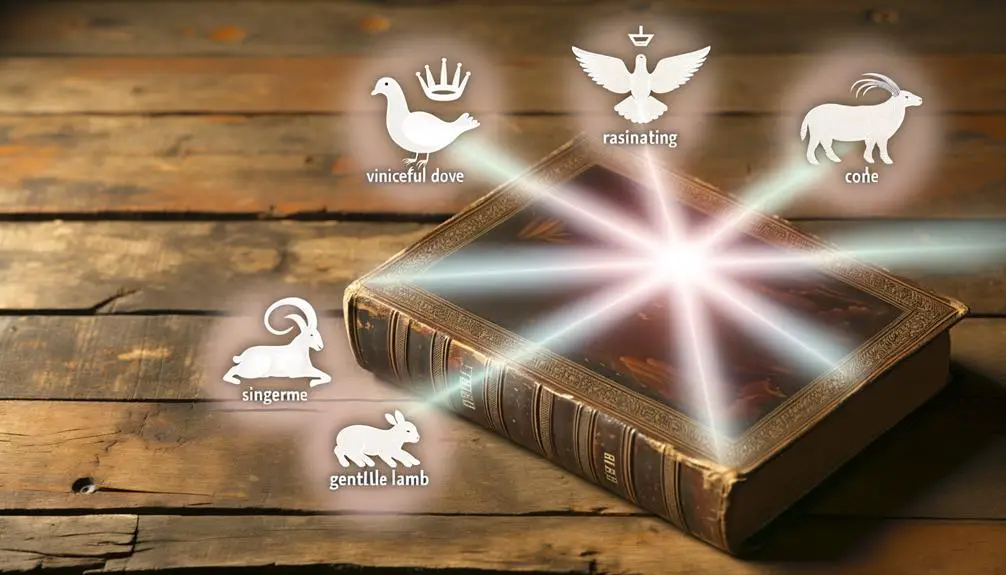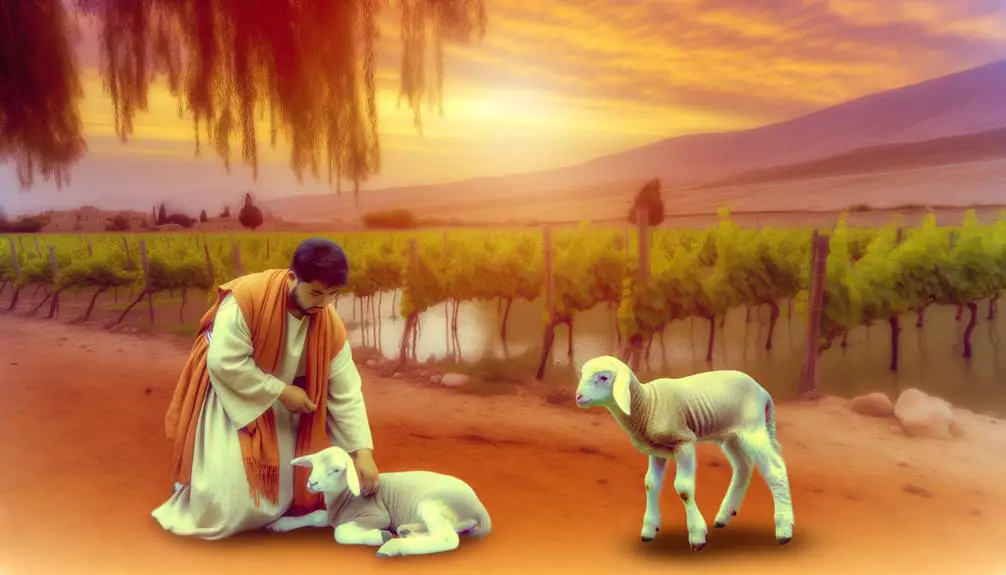Yielding profound spiritual insights, biblical allegories intertwine symbols and stories to reveal deeper truths—discover what they unveil.

Definition of Allegory in the Bible
In the Bible, an allegory is a narrative that uses symbolic figures, actions, and imagery to convey deeper ethical, spiritual, and moral truths. You'll encounter literal events intertwined with these profound meanings, urging you to interpret both the surface story and its underlying messages. This blend of storytelling and symbolism is influenced by historical context as well as cultural and rhetorical nuances, which have evolved over time. For instance, symbols like water and gardens often carry spiritual significance, representing life-giving qualities or moral growth. Exploring biblical allegories further will reveal layers of theological insights, enhancing your understanding of complex spiritual themes.
Key Takeaways
- An allegory in the Bible is a symbolic narrative that expresses spiritual, moral, or ethical truths.
- It uses characters, events, and details metaphorically to convey deeper meanings.
- Biblical allegories often involve extended metaphors that unfold throughout a story, revealing multiple layers of interpretation.
- These stories are crafted to engage readers, prompting reflection on complex theological and moral issues.
- Allegorical interpretation requires analysis of both the literal narrative and the symbolic significance tied to historical and cultural contexts.
Understanding Biblical Allegory

To ponder biblical allegory, you must first acknowledge its role in conveying profound spiritual truths through symbolic storytelling. Allegories in the Bible function as multifaceted narratives, weaving together literal events with deeper symbolic meanings, often reflecting ethical, spiritual, or moral lessons. Understanding these allegories involves delving into both the surface story and its underlying messages, which are crafted to resonate on multiple levels with their audience.
Modern interpretations of these allegories often hinge upon contemporary allegorical methods, which emphasize context, cultural nuances, and the evolution of language. You'll find that modern scholars tend to dissect these narratives with a fine-tooth comb, applying historical-critical methods alongside literary analysis to unpack the text's layered meanings. This approach helps to bridge the gap between ancient scriptural contexts and today's diverse cultural landscapes, making the allegorical content more accessible and relevant.
Crucially, these interpretations challenge you to ponder not just what the biblical text says, but what it does—how it works within itself and influences its readers. By engaging with these allegorical methods, you're equipped to uncover the rich tapestry of meanings that might otherwise remain obscured by time and translation. This deeper understanding fosters a more nuanced appreciation of the Bible's allegorical narratives.
Historical Context of Allegories
Understanding biblical allegories better, you'll find that their historical context greatly influences their meaning and interpretation. In the times the Bible was written, cultural influences and ancient rhetoric shaped how stories were told and understood. These allegories weren't merely artistic; they were deeply embedded in the social and political fabrics of ancient societies.
Consider how the allegories reflected the norms, values, and struggles of the time. Ancient rhetoric, with its sophisticated techniques of persuasion and argumentation, played an important role in how these stories were crafted. This rhetoric wasn't just about embellishment but was a crucial tool in making complex religious and moral ideas accessible and compelling to the public.
The use of allegory allowed biblical authors to discuss controversial or sensitive topics in a manner that was both engaging and safe. By encoding messages about governance, morality, and divine justice into allegorical stories, they could communicate with audiences across different strata of society without direct confrontation.
Thus, when you're examining biblical allegories, it's significant to consider not just the text but the historical milieu that influenced its creation. This understanding doesn't just add depth to your interpretation; it bridges the gap between ancient script and contemporary analysis.
Symbols and Their Meanings

In biblical allegories, each symbol carries a profound meaning, often reflecting complex theological, moral, and societal themes. As you explore these narratives, you'll find that symbolic colors and metaphorical landscapes are not just decorative elements but are imbued with deep significance:
- White and Purple: White often symbolizes purity and holiness, appearing in contexts suggesting righteousness (Revelation 7:9). Purple, a color of royalty, signifies authority and wealth, reminding you of the sovereignty of God or the corruption of materialism (Revelation 17:4).
- Deserts and Gardens: Metaphorical landscapes like deserts can represent spiritual barrenness or trials (Matthew 4:1-11), whereas gardens might symbolize restoration and peace, echoing Eden and pointing towards renewal (John 19:41).
- Water: Frequently, water signifies cleansing or life-giving properties, reflecting spiritual rebirth (John 3:5).
- Bread: This common element symbolizes sustenance and life, often representing the word of God or the body of Christ in communion rituals (John 6:35).
- Lamb: A central symbol in biblical allegories, the lamb represents sacrifice and redemption, pivotal to understanding the narrative of salvation (Revelation 5:6).
These symbols serve as keys to revealing deeper theological insights, guiding you through a layered understanding of the scriptures.
Allegory Versus Parable
While both allegories and parables are literary devices used to convey deeper meanings, they differ significantly in structure and purpose. You'll find that allegories consist of extended metaphors where elements within a narrative correspond to elements outside the narrative, often embodying broader abstract principles. They are intricate, crafted with multiple layers of meaning that persist throughout the story. Parables, on the other hand, are succinct, simple stories used to illustrate a single moral or spiritual lesson. They don't typically extend their symbolism beyond the key message.
Diving into their comparative origins, parables are deeply rooted in oral traditions, designed to be easily remembered and repeated. They are prevalent in many cultures but are particularly prominent in the teachings of Jesus in the New Sacred Writings. Allegories have a broader literary usage across cultures and historical epochs, often utilized in written texts to explore complex philosophical and ethical issues.
The narrative structures of these two devices also reveal their distinct purposes. Allegories often unfold over an extended narrative—think of works like John Bunyan's 'Pilgrim's Progress', where every character and event symbolizes a different aspect of the Christian journey. Parables, in contrast, are typically concise, delivering a punchy, impactful moral revelation in a brief episode.
Key Allegorical Figures

As you explore key allegorical figures in the Bible, you'll encounter the Parable of the Sower, which symbolically discusses the reception of God's word among different types of hearts. The Prodigal Son analysis reveals layers of redemption and familial relationships, reflecting broader theological themes. Lastly, insights from the Good Samaritan underscore the expansive definition of 'neighbor' and challenge preconceived notions of morality and piety.
Parable of the Sower
One must carefully analyze the Parable of the Sower, where key allegorical figures such as the seeds, the soil, and the sower himself, embody profound spiritual truths. The seeds symbolize the word of God, and their fate depends on the soil they fall on, representing human hearts. The process of seed germination is vital, as it allegorizes the initial reception of divine messages.
- The Sower: Represents those who disseminate spiritual teachings.
- Pathway Soil: Hearts hardened by sin, preventing spiritual growth.
- Rocky Soil: Shallow hearts that initially accept the word but falter under pressure.
- Thorny Soil: Lives overwhelmed by worldly anxieties, stifling spiritual maturity.
- Good Soil: Receptive hearts that nurture and propagate the teachings effectively.
Understanding soil types enriches the interpretation of how spiritual conditions affect receptivity and growth.
Prodigal Son Analysis
Similarly to the Parable of the Sower, the Prodigal Son offers rich allegorical figures, including the father, the elder brother, and the prodigal son himself, each encapsulating distinct spiritual and moral dimensions. In this narrative, the father's forgiveness is pivotal, symbolizing divine grace that is limitless and unconditional. The elder brother's response offers a contrast, highlighting human frailty in compassion and understanding. Meanwhile, the prodigal son's repentance is a powerful motif of redemption and personal transformation.
Here's a breakdown of their allegorical meanings:
Character |
Symbolic Meaning |
|---|---|
Father |
Divine forgiveness, unconditional love |
Elder Brother |
Human judgment, self-righteousness |
Prodigal Son |
Repentance, moral and spiritual rebirth |
This parable intricately weaves these themes to reflect on the nature of forgiveness and the complexity of human and divine relationships.
Good Samaritan Insights
In the Parable of the Good Samaritan, key allegorical figures such as the Samaritan, the injured man, and the priest provide deep insights into the themes of compassion and societal prejudices. This story, rich in symbolic meaning, resonates through its characters:
- The Samaritan: Represents unanticipated kindness, challenging cultural interpretations of morality and societal roles.
- The Injured Man: Symbolizes vulnerability and the universal need for compassion, regardless of one's background.
- The Priest: Reflects religious and social expectations that often fall short in practice.
- The Levite: Demonstrates how adherence to societal norms can lead to moral failures.
- The Innkeeper: Serves as a lesser-examined figure, symbolizing the facilitation of healing within communal settings.
These figures underscore the timeless relevance and modern applications of the parable.
Allegories in the Old Testament

The Old Scripture frequently employs allegory to convey deeper spiritual truths and moral lessons. You can see this most clearly in the narratives of Genesis creation and Joseph's dreams. The Genesis creation account, beyond its literal interpretation, serves as an allegory for the order and intentionality of the universe. It reflects the idea that the world isn't a product of random forces but is created with purpose and wisdom. This story invites you to contemplate the nature of God as a deliberate creator who brings order out of chaos, suggesting a moral order to which humanity should aspire.
Similarly, Joseph's dreams, which predict his rise to power and the future necessities of his family, aren't just personal or historical accounts. They exemplify how individual destiny can serve broader divine purposes. These dreams allegorically illustrate themes of providence, redemption, and forgiveness. Joseph's ability to interpret dreams underscores the value of spiritual insight and foresight, preparing you for how actions align with cosmic plans.
Understanding these allegories helps you grasp the layered meanings in biblical texts. They teach you not only about historical events but also about moral and spiritual principles guiding human conduct.
Allegories in the New Testament
Moving to the New Covenant, you'll find that allegories continue to play a significant role in conveying spiritual truths and ethical teachings. The New Agreement texts enrich the tradition of allegory, deploying it to deepen the understanding of Christ's teachings and the unfolding Christian narrative. The use of allegory helps bridge the old and the new, weaving a seamless theological fabric that connects Jewish heritage with the emergent Christian ethos.
Here are some key allegories that illustrate profound truths in the New Agreement:
- Parable of the Sower: Reflects on the reception of the Kingdom of God across different types of hearts, symbolized by soil conditions.
- Parable of the Good Samaritan: Challenges traditional ethnic boundaries, promoting a broader understanding of neighborly love that underscores Gentile inclusion.
- Parable of the Prodigal Son: Represents God's forgiveness and the return to spiritual awakening, akin to a metaphorical resurrection.
- Parable of the Vineyard Workers: Addresses divine grace that defies human economic norms, emphasizing equality in God's Kingdom.
- Parable of the Mustard Seed: Symbolizes the Kingdom of God's humble beginnings and expansive growth, encouraging faith in seemingly small beginnings.
These allegories aren't just stories; they are theological instruments, encapsulating complex doctrines in relatable terms.
Interpretative Challenges

As you explore allegories within the biblical text, you may encounter significant challenges in identifying which elements are allegorical and which are not. The context in which these scriptures were written is vastly different from today's world, complicating your understanding of their original intent and meaning. Each allegory demands a rigorous examination of historical, cultural, and linguistic factors to fully grasp its nuances and implications.
Identifying Allegorical Elements
Identifying allegorical elements in biblical texts poses a significant challenge, as you must discern between literal and symbolic meanings within the same narrative. This process is intricate due to the blend of literary techniques and narrative structures designed to convey deeper truths.
- Contextual Cues: Look for hints within the text that suggest a deeper, symbolic meaning beyond the obvious.
- Character Roles: Analyze characters whose actions or experiences might symbolize broader concepts.
- Recurring Symbols: Note objects or events repeated throughout the narrative.
- Language Patterns: Pay attention to shifts in language that suggest a move from literal to metaphorical.
- Narrative Inconsistencies: These can signal an underlying allegorical intent, challenging you to think beyond the surface.
Contextual Understanding Difficulties
While exploring allegorical elements offers insight, you'll find interpreting these contextual nuances within biblical texts equally challenging. The biblical era's linguistic nuances and cultural barriers can obscure the original meanings of allegories. You're grappling not just with a text, but with a text shaped by distant historical contexts and languages. These layers of separation demand a meticulous approach to understand how original audiences would have perceived these allegories. For instance, without a deep knowledge of ancient Near Eastern culture, you might miss the significance of metaphorical references that were clear to contemporary readers. Achieving a thorough comprehension requires bridging these gaps, demanding not only linguistic skill but also a profound understanding of historical and cultural backdrops.
Theological Implications
The use of allegory in the Bible presents profound theological implications, affecting how you interpret core doctrines and divine narratives. By engaging with allegorical texts, you explore deeper into the layers of meaning that influence your understanding of moral transformation and divine communication. These allegories aren't just ancient texts; they're dynamic frameworks through which you can examine complex theological concepts.
Here are some significant aspects to contemplate:
- Nature of God: Allegories often portray God in multifaceted ways, challenging you to think beyond simplistic interpretations and appreciate the depth of divine character.
- Human Nature: Through allegorical stories, you gain insights into the human condition, reflecting on tendencies towards sin and the potential for redemption.
- Salvation History: Allegories can enrich your understanding of salvation, illustrating how historical events weave into the grand narrative of redemption.
- Moral Lessons: These stories frequently encapsulate moral teachings, offering guidance on how to live in alignment with God's will.
- Eschatological Themes: Allegories provide glimpses into the end times, encouraging you to reflect on eschatological promises and warnings.
Allegory in the Bible doesn't just tell stories; it invites you into a theological dialogue that has the power to transform your spiritual perspective and deepen your faith.
Enhancing Spiritual Readings

Building on the theological insights provided by allegory, let's explore how these narratives can enhance your spiritual readings and deepen your engagement with sacred texts. Allegories in the Bible function as spiritual metaphors, which, when deciphered, can reveal profound spiritual truths and ethical teachings. By viewing stories like the parable of the Good Samaritan or the Prodigal Son as more than historical or surface-level events, you're invited into a deeper contemplative practice.
These allegorical narratives prompt you to question and reflect, not just on the text's meaning but also on its application to your own life and spiritual journey. For instance, the allegory of the Vine and the Branches in the Gospel of John isn't merely about agricultural practices; it's a call to understand your relationship with the divine, emphasizing interconnectedness and dependence on spiritual nourishment.
Engaging with these layers of meaning requires a mindful approach. You'll benefit from adopting a meditative reading stance, where you read slowly, reflect deeply, and perhaps journal your insights. This type of engagement isn't just about acquiring knowledge but about transforming understanding into lived experience and wisdom, thereby enriching both your spiritual life and your daily actions.
Frequently Asked Questions
Can Allegories Be Found in Non-Religious Texts?
Yes, you'll find allegories in non-religious texts, rich with literary symbolism woven into cultural narratives. These narratives analyze human experiences, offering profound insights into societal values and individual psychology.
How Do Children Interpret Biblical Allegories?
You'll find that childhood comprehension of biblical allegories relies heavily on teaching strategies. Simplified narratives and relatable analogies enhance understanding, enabling a deeper engagement with these complex, symbolic stories from early ages.
Are There Any Modern Adaptations of Biblical Allegories?
Yes, you'll find modern adaptations of biblical allegories in contemporary films and literary reinterpretations, reflecting nuanced perspectives and ethical dilemmas that resonate with today's societal issues and personal struggles.
How Do Allegories Differ in Other Religious Texts?
Allegories in other religious texts, through comparative analysis, show varied cultural influences shaping their narratives. You'll find distinct symbolism and moral teachings diverging from biblical examples, reflecting diverse theological and philosophical traditions.
What Are Some Common Misconceptions About Biblical Allegories?
You might think biblical allegories always demand literal interpretation or historical accuracy, but they're often symbolic, aiming to convey deeper truths rather than factual precision. This common misconception can skew your understanding.



Sign up